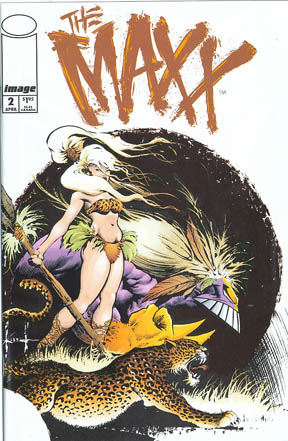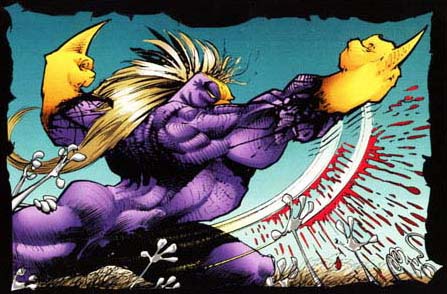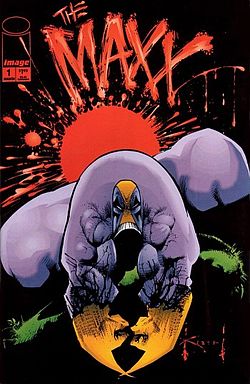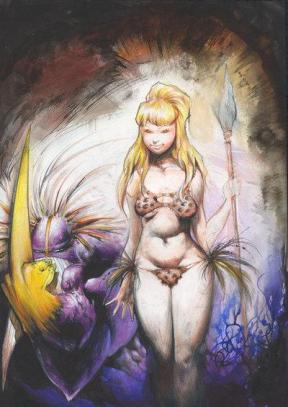Art of the Genre: What came first, the writer or the artist?
As I walked into the office today Ryan Harvey was talking Avengers with Kandi at the front desk, a figurine of Captain America in his hand and a smile on his face. Now, for any of you who don’t know, Cap isn’t my favorite super hero. I’m not saying I dislike Cap, but when it comes to heroes, and the Avengers in particular, my personal hero is Tony Stark, aka Iron Man.
Ryan, for his part, can’t stand Iron Man, so the office is often a place of contention between the two heroes, and with this new movie coming out the debate has been taken up a notch.
Still, there’s an interesting note about both heroes, and that is the depth in which people are vested in them. Comic book characters, by their very nature, should inspire people to both discuss and enjoy what lies beneath the costume even more than what happens while the person is in it.
Some might argue that comics are about the art, and there have been times when this was abundantly true, but the hard reality is that at their core it’s really the story that matters. In the world of comics, everything America knows and loves about its heroes was the creation of a writer, the art involved that helped galvanize their place in our subconscious a simple technicolor window-dressing that was added later to an already solid foundation, or so I would contend.
Walking by Ryan, I lifted his Captain America figure from his hand, unceremoniously dumped it in the trash, and then went into my office to write the beginnings of a tale I hope you’ll all find interesting. Now granted, I’m biased here, but since no one jumped up to storyboard this particular piece, it will have to stand on the words alone [although there are pictures… there are always pictures, because John O’Neill once told me that if you want readers for your blog you need to include lots of images because people love them… go figure.]
In the spring of 2008 my wife and I were getting ready to sell our home in Maryland for a move to Los Angeles. To accomplish this, some things simply had to go, and reading between the lines that it actually meant my stuff had to go…
Yep, my three-hundred year old Chinese pavilion door turned gaming table… gone! My office… gone! My basement gamer’s den bone horse statue, folding wall hangings, and old English bookcases… gone!
The topper, however, were my twenty-three long boxes of comics. This mighty collection began in a drug store in Monticello, Indiana in 1980 with my very first comic, Avengers #194 and stretched to somewhere around 1998. It was both painful and a needed release, the boxes having become a loadstone to my existence as I’d moved them six times and had stopped reading them more than fifteen years before, the bulk having never even been opened.
Now, what do you do with so many comics? Well, in 2008 you went to eBay and started listing large lots of them. In this fashion I got to see firsthand what ‘collectors’ comics were really going for.
What did I find out? Well, that comics were a horrible investment, and that the few thousand dollars I spent on so many comics would have been much better served if I’d simply bought an Action Comics #1 for $6,000 in 1985 so I could have sold it in 2011 for $2.1 Million…
Nonetheless, the sales started coming in, and old school runs of Avengers, Excalibur, West Coast Avengers, New Mutants, X-men, etc went for up to $3.00 an issue in the very best of circumstances. Inside some runs there were indeed ‘gems’, and they would bring $20-$50, but for the most part the collection was really only valued as a bulk sale, probably to comic shops looking to hold the stock in hopes of later resale at a slight mark-up.
The above comics, however, were only a piece of my collection, the mass of it purchased during the ‘comic boom’ of the early 90s. In that time I was in college and was looking to become a comic’s gold prospector, my intellect used to corner the market with shrewd purchases of comics certain to become so valuable I’d buy a house with their appreciated value by the time I was ready to sell.
These books, for the most part, came out of a brand new comic powerhouse studio called Image! You know, now that I think about it, Image! was the perfect name for this company as that’s really all they were selling.
The story, in short form, is this: Todd McFarlane, sick with his new comic power that he’d already lorded over Marvel when he got his own personal line of Spider-man comic, got together with X-Men hot commodity Jim Lee, and New Mutants/X-Force wonder-kid Rob Liefield to make a studio where they didn’t have to listen to Marvel or DC, they could make their own intellectual property, AND most of all, they could write their own comics.
Okay, now that last piece is the thing that rubs me the wrong way. You see, it’s hard to write… well, I should say it’s hard to write well. I should know, I’ve been doing it since the 7th grade and I still suck 75% of the time.
These young Turks wholeheartedly believed they could do both jobs and that their stellar artistic skills [well all but Liefield] would translate into verbal gold, but I can tell you this, it didn’t. With a growing talent pool of Marvel domination-escaping artists like Whilce Portacio, Marc Silvestri, Erik Larson, Jim Valentino and countless others by the end run the study was ripe with art and rotten with writing.
Still, their books rolled out into at the height of the boom, and people were going crazy with them, snatching up two, five, even fifty copies of issues 1-10 of most of the burgeoning series coming off the Image presses.
It was utter insanity, as any good boom is, and as I started listing my copies of these now twenty year-old books, I came to realize just what trash they really were. Indeed, they were nothing by eye-candy, even the ‘Batman’ in their closet, McFarlane’s Spawn, was worth less than the paper it was printed on.
Fame is fleeting, as is artistic taste, and even as pretty as these books were in 1992 they were aged and discarded quickly when the bottom dropped out of the market. Seriously, I’ll give anyone a high five if they can tell me any of Jim Lee’s characters from his time at Image, or better yet, the name of his first title!? I mean, Lee was the hottest thing since the Dark Knight in comics when he defected and as I write this I have no idea what his comic was, and I OWNED IT!
What did I get for my five boxes of Image! books? Well, thankfully a lot more than I would have figured once I saw what they were bringing on the open market.
How can this be, you might ask? Well, one reason, Sam Keith. Sam, like the rest of Image! was an artist, a mid-level artist really with a talent for making beautiful things look bad, or perhaps bad things looks beautiful… which is by far my favorite kind of art. Still, Keith knew his limitations and he accepted what he was… just an artist. So what did Sam do when he joined up with Image!? He got himself a writer, that’s what, and not any writer, but the incredibly talented Alan Moore of Watchman fame to help flesh out concepts as well as William Messner-Loebs for scripting [although Moore did write the full #21 comic himself].
When fanboys and investors were scrambling for the next bikini-clad babe and rail-gun wielding Abercrombie model from the ‘big guys’ at Image!, Keith’s odd and buck-toothed hero The Maxx was being utterly ignored on racks across the nation… that is, by everyone but me.
Now I’m not saying I’m a fortune telling genius, I mean I got suckered as much as anyone, but I did see merit in Keith’s art, and how can anyone turn their nose up at Alan Moore and Messner-Loebs?
Unlike many… nay, I’ll say ALL of my friends at the time, I bought every issue of The Maxx, even including the ½ issue that was order only from Wizard Magazine.
Fast forward 20 years and suddenly my horrible investment in Image! quickly became a honest profit all because of a 35 issue run that lasted from 1993-98.
What does this prove? Well, that speculating on anything is both volatile and dangerous [just ask the Dutch and their tulips] and…. AND… that writing IS important because what Keith, Messner-Loebs, and Moore did was create an extraordinary tale of a serial killer, insanity, rape and poverty that spans two worlds and is utterly captivating.
The Maxx, and Sam’s vision to create it, kept Image! from being a total waste of an company [until The Walking Dead was released in 2003 when they’d at last learned they needed a writer to come up with a lasting story].
Captain America, for all his faults in my mind, still has a story, and a writer who created him, just like Iron Man. They prove, just like The Maxx, that when creative people get together they have a much better chance of doing things that people remember than when one tries to take all the glory for themselves.
So, in conclusion, if I have a point with all this, it’s that covers sell books, but no matter what you can’t judge a book by its cover. Artists need writers as much as writers need artists, but often times artists tend to forget that fact…




Scott you’re wrong!
YES Sam Keith got a writer to help him develop The Maxx, and that writer was Bill Messner-Loebs. Alan Moore ONLY wrote one issue of The Maxx (issue 21) during his time at Image. However Moore is supposed to have done some amazing work on Supreme (don’t know, didn’t read it) and created the brilliant, but aborted 1963 series (part of which is supposed to be seeing new life, thanks to artist and co-creator, Steve Bissette).
But you are right about the story being just as (if not more) important to comics as the pictures. I heard a joke that in response to the creation of Image comics, several writers were considering beginning their own company, just to name it “Substance”!
A fine story, Scott. I remember THE MAXX well… Sam’s art really stood out among all the high-gloss superhero stuff IMAGE was doing 15 years ago. Any idea what he’s doing now?
Oddcube: Wow, I knew William Messner-Loebs scripted the Maxx with Keith, but back in the day when I was reading these Moore was credited with ‘writing’ it although I guess that could be in a creation-type standpoint. I wish I knew Keith, then I could ask him for the full story! Awesome info though, so thanks for filling me in!
John: Nope… but I could try to find out 😉
Scott: I agree that the Maxx was the best of the early Image books (Jim Lee’s title was WildCats, featuring Grifter, Zealot, and … umm … that size-changing guy who got dumber as he got bigger … umm … some other folks …). But Moore only guest-wrote one issue (Wikipedia says 21). Moore did that from time to time; when McFarlane got criticism for the terrible writing in Spawn, he got Moore, Neil Gaiman, Frank Miller, and Dave Sim to each guest-write an issue. Which then turned into a legal quagmire when McFarlane began turning Gaiman’s creations into action figures … oh, it was a mess.
In terms of the larger point about writers … well, I agree and disagree. I’m working on a post that’ll go up soon about the Kirby FF. Note that I say ‘Kirby FF’ and not ‘Lee FF’. It’s pretty clear that the person to whom the writing was attributed was not the main creative force behind the book — much of what one would call ‘writing’ was in fact done by the artist. Jack Kirby could do that because he was a talented storyteller. Steve Ditko, same thing. Lee, McFarlane, Liefeld … not really. I think Lee has a talent for rendering, McFarlane has some decent cartooning instincts, but I’ve never really been convinced by their graphic storytelling, to say nothing of plotting ability or sense of character.
So I agree that good writing is important, whether it comes from the guy credited as the writer or not. But I have to really disagree with the argument that collaboration is likely to be better than single voices. Call me an old-school Romantic, but I’m much more of the ‘no great art was ever created by committee’ philosophy (which, yes, ignores gothic cathedrals and the King James Bible and so forth. I still think it’s more nearly right than the other position). As I say, the problem is with the individual artist. Hergé, Tezuka, Dave McKean … these are people who’ve done great work all on their own. Comics artists from Herriman to Bill Watterson have I think actually done better stuff alone than they could with a writer — because they know what they can do, because they can see possibilities for their art that people outside of their head can’t see until it’s been done.
Or to put another way: they’re great artists, and also talented writers. It does happen that the two gifts turn up in one person. When it does, you get great comics.
Matthew: Ala Frank Miller, who has both, or did until the insanity set in… 😉
And certainly, it does happen, but I believe it is very easy for an individual, especially one that gets loads of credit for the art they are producing, tends to have an overblown sense of worth when it comes to their overall creativity. Lee, McFarlane, Liefeld fell into this trap as comic artists, David Lee Roth as the lead singer of a Van Halen, or even Holly Black who seemed to be the writer for Spiderwick only to find out that DiTerlizzi was both a grand storyteller AND artist in the series.
And as we both argue above, nothing is set in stone because for every dozen Roths there is a Sting… my only contention is that its simply easier to do a single artistic thing well than be a master in many. Stick to the talent you were given, and just because you can paint beautiful pictures it doesn’t mean you’re Hemingway.
I loved the Maxx, I remember many a beer/whiskey soaked discussion around a dice covered table a decade and a half ago about what it all meant…
>>Ala Frank Miller, who has both, or did until the insanity set in… 😉 <<
If the truth is insanity, call me Insane!!!
😀
Comics are tricky because to be a good comics artist you need to have some modicum of storytelling talent. The Image founders didn’t really have any of that (I STRONGLY disagree with the “stellar artists” bit) but were financially successful because of some really kooky collective delusions or naivety on the part of the audiences of the time. But most of the Great Comics Creators are cartoonists – Foster, Caniff, Kirby, Eisner, Barks, Joe Kubert, etc. – and not so much “pure writers”, although there have also been some great comics writers, too 🙂
TW: Too funny, and yes Maxx was great!
Andy: Comics are tricky because they really require BOTH writing and art, so the argument gets murky very quickly.
Personally I was wild about “The Maxx” when it first came out, and waited eagerly between…long deadlines missed…issues for each installment. But, IMO, the series really petered out after 20 or so. Turned from a cool modern fantasy with “Primitivist” appeal to just bored nose ringed Gen-Xrs and “I had this trauma, waaahhh” stuff. Likewise, they had this cool MTV series, “Oddites” but it also Cr—ed out about where I cr—ped out bored of the comic. Then they finished and worked on the silly but strangely good “The Head”…
Frankly, we are touching a good thing here: Art versus story.
For “The Story” well that 80s tv show “Amazing Stories” did it perfectly; It started with a Shaman telling great tales around the fire to his tribe.
Of course there is also the ancient cave drawings, the vibrant buffalo, the “Horned God” shaman image…
In abstract I’d be for the “Story” to be the leader in that. “The Story” has suffered much recently, being reduced to crude and often vulgar entertainment, with only social propaganda crudely and rudely forced in. Art has gained much, both with technology and to make up for the suffering of “The Story” but still that’s the problem with “Mainstream” stuff and “Politically Correct mass-media stuff”… It tends to have very GOOD artists and very BASIC or controlled and limited writers. (“Obey, or your daughter is the sacrifice at the next Grove meeting, you did sign that pact in BLOOD!) Just look at all these recent rounds of movies for example, the production values and CG is awesome but the stories suck……well don’t need to use 20k of excessive vulgarity, do I? How many writers go “If I had that production team and could control the story…”?
Overall it’s that the better writers often can’t doodle more than a stick figure or child/high school sketch level at best and the great artists suck at making actual stories.
But, can you tell a story with pure ART and have the ART itself be a story? Not just a “Textless” comic experiment, those are done already. But, can you have the art itself work/a phenomenal artist make a story too either with his work or aside from writing it?
That’s too broad a question to answer directly, but I think the late, great “Frazetta” is a good example. He’s far, far known better as an illustrator of which he has virtually no peer. I like his stories too, the few he’s done, like “Thun’da King of the Congo” – done just before the PC Mafia started ruining popular culture, much to his surprise…
But Frazetta’s work was so awesome it literally INSPIRED stories. Seriously, there’s a point in one of his books, all his misc. paperback art, where he literally made the stories with his covers. In response to a tiff with an editor/critic on one of his “Roman” paintings not being “Historically Correct” an editor said “Fraz; Send us pictures at your usual best. We’ll pay YOU for the picture and order one of our hacks to hammer out some kinda plot, ok?” and Fraz both wanted the money and that total artistic freedom. Lots of cool stuff like “Flame Demon” were spawned by this.
But the best of it was his “Death Dealer”. Just that lonely, menacing figure on the horse with his axe, the perfect pose and balance of elements. They later made a story and a rather extreme comic series. Fraz himself liked Danzig but hated what he did with some of his stuff, the violence and sexuality in Jaguar God (a variant image of “Darkwolf” character design) and Death Dealer. But even that argued my point, his art truly achieved a life of it’s own, inspiring far more than the obvious “Scary warrior guy on a horse” thing…
Green: Well made points! As for art inspiring, I have to agree that great art tells its own tale and can inspire words from writers where none existed before. That kind of creative synthesis can also be found in nature, a daring vista, a tangled city, a storm blowing across the waters of a grey sea. All these visual stimuli can inspire words, just as a man-created image, so why can’t a book cover come before a book?
Working with artists as closely as I do, I can tell you that I’ve seen personal collections and have often asked, ‘can I write a story about this image?’ which to my joy has always been followed with a gracious ‘yes’.
I also considered cave painting and came to the conclusion that it represents a visual record of events, more pictograph than art, but nonetheless was certainly spawned to help others ‘remember’ great stories told around a cave fire of things witnessed in seasonal hunts. They then become writing without words, which is what all pictures truly are, and thus what came first… well the answer is both and neither. 😉